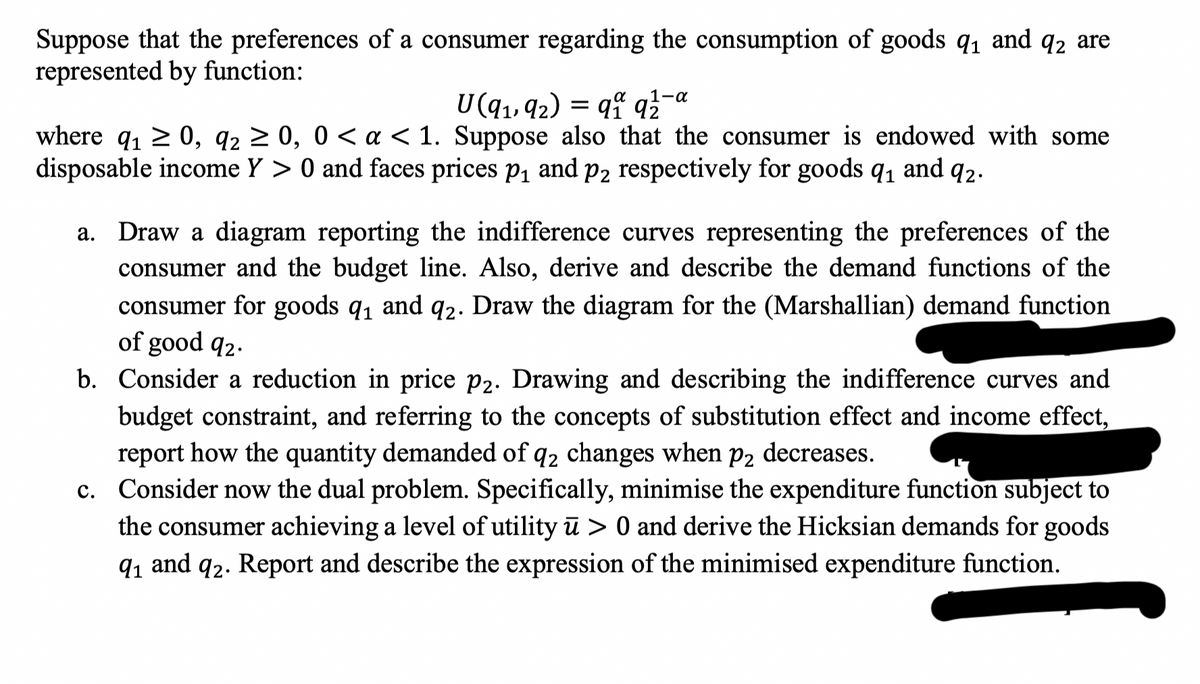Suppose that the preferences of a consumer regarding the consumption of goods q₁ and q2 are represented by function: -α U(9₁,92) = q 9²2- where q₁0, 92 ≥ 0, 0 < a < 1. Suppose also that the consumer is endowed with some disposable income Y> 0 and faces prices p₁ and p2 respectively for goods 91 and 92. a. Draw a diagram reporting the indifference curves representing the preferences of the consumer and the budget line. Also, derive and describe the demand functions of the consumer for goods q₁ and q2. Draw the diagram for the (Marshallian) demand function of good 92. b. Consider a reduction in price p2. Drawing and describing the indifference curves and budget constraint, and referring to the concepts of substitution effect and income effect, report how the quantity demanded of q2 changes when p2 decreases. c. Consider now the dual problem. Specifically, minimise the expenditure function subject to the consumer achieving a level of utility ū> 0 and derive the Hicksian demands for goods 91 and 92. Report and describe the expression of the minimised expenditure function.
Suppose that the preferences of a consumer regarding the consumption of goods q₁ and q2 are represented by function: -α U(9₁,92) = q 9²2- where q₁0, 92 ≥ 0, 0 < a < 1. Suppose also that the consumer is endowed with some disposable income Y> 0 and faces prices p₁ and p2 respectively for goods 91 and 92. a. Draw a diagram reporting the indifference curves representing the preferences of the consumer and the budget line. Also, derive and describe the demand functions of the consumer for goods q₁ and q2. Draw the diagram for the (Marshallian) demand function of good 92. b. Consider a reduction in price p2. Drawing and describing the indifference curves and budget constraint, and referring to the concepts of substitution effect and income effect, report how the quantity demanded of q2 changes when p2 decreases. c. Consider now the dual problem. Specifically, minimise the expenditure function subject to the consumer achieving a level of utility ū> 0 and derive the Hicksian demands for goods 91 and 92. Report and describe the expression of the minimised expenditure function.
Chapter3: Preferences And Utility
Section: Chapter Questions
Problem 3.7P
Related questions
Question

Transcribed Image Text:Suppose that the preferences of a consumer regarding the consumption of goods 9₁ and q2 are
represented by function:
1-α
U(9₁, 92) = 91 92
where q₁ ≥ 0, 9₂ ≥ 0, 0 < a < 1. Suppose also that the consumer is endowed with some
disposable income Y> 0 and faces prices p₁ and p2 respectively for goods 9₁ and 92.
a. Draw a diagram reporting the indifference curves representing the preferences of the
consumer and the budget line. Also, derive and describe the demand functions of the
consumer for goods 9₁ and 92. Draw the diagram for the (Marshallian) demand function
of good 92.
b. Consider a reduction in price p2. Drawing and describing the indifference curves and
budget constraint, and referring to the concepts of substitution effect and income effect,
report how the quantity demanded of q2 changes when p2 decreases.
c. Consider now the dual problem. Specifically, minimise the expenditure function subject to
the consumer achieving a level of utility ū> 0 and derive the Hicksian demands for goods
9₁ and 92. Report and describe the expression of the minimised expenditure function.
Expert Solution
Step by step
Solved in 10 steps with 10 images

Knowledge Booster
Learn more about
Need a deep-dive on the concept behind this application? Look no further. Learn more about this topic, economics and related others by exploring similar questions and additional content below.Recommended textbooks for you

